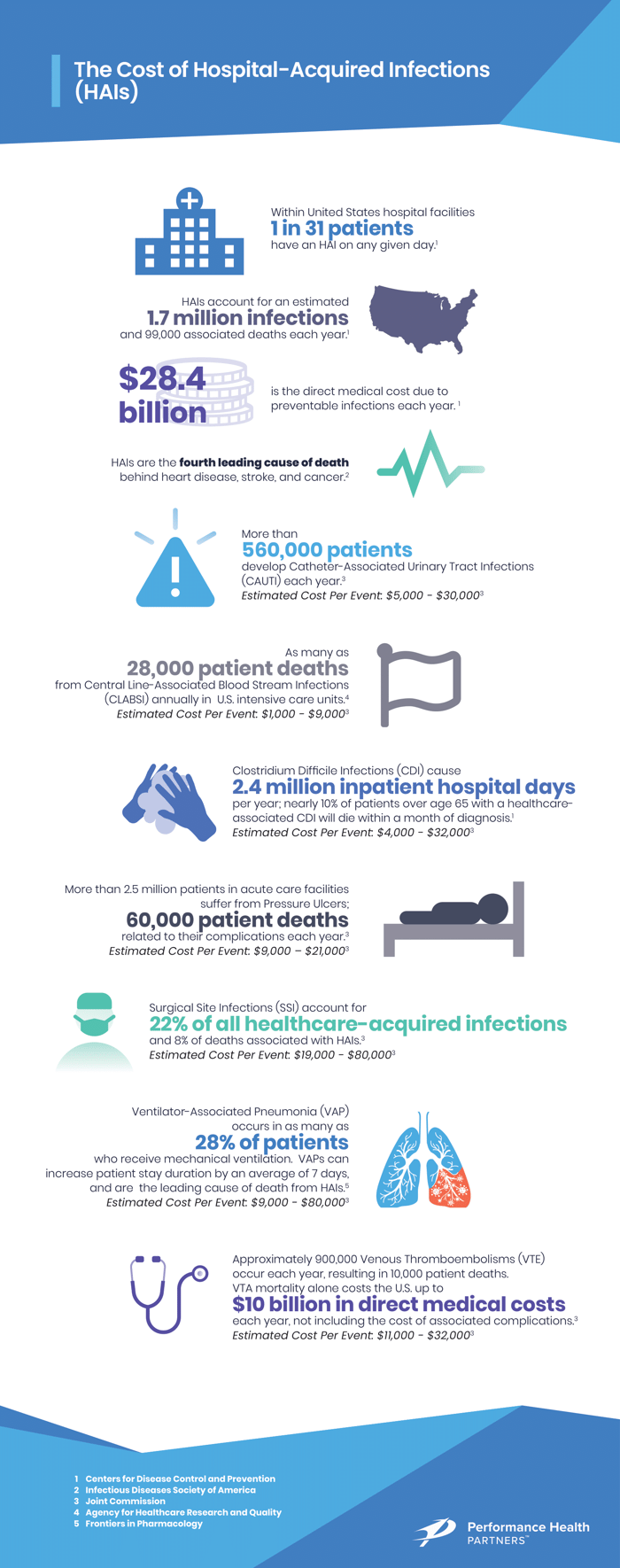2 min read
Reducing HAIs Through A Healthcare Reporting System
Performance Health Partners
July 28, 2020

The Center for Disease Control estimates that 1 in 31 hospital patients has an HAI on any given day. (1) Although many HAIs are preventable, their high prevalence leads to harmful effects on patients’ physical, mental, and financial health—and cost billions of dollars in added expenses to the healthcare system.
Health economists at the CDC estimate that the annual costs of HAIs in the United States are between $28 billion- $45 billion per year. (1)
With the healthcare industry’s movement towards value-based care, reductions in HAIs are also becoming increasingly tied to reimbursement. (2) Studies indicate that hospitals that provide a higher quality of care (represented by lower HAI rates) have better overall patient satisfaction scores. (3) Higher quality scores result in increased reimbursement levels for healthcare systems—reducing HAIs a top priority for improving both patient and financial outcomes.
How can HAIs be prevented? Recent studies point to reporting as a possible answer. (4)
Benefits of a Healthcare Reporting System
Establishing a process for reporting HAIs has the following benefits:
1. Increase Hand Hygiene Compliance
Establishing a streamlined process for reporting makes it easier for care teams to conduct hand hygiene rounds across departments and increase compliance over time.
One study of an 853-bed facility showed that increased adherence to hand hygiene policies (>80%) led to hospital-wide decreases in HAIs during the 17-month study period. (5)
2. Ensure Proper Follow-up of HAIs
When an HAI is reported, it’s essential to make sure that information gets to the right people promptly to be resolved. A healthcare reporting system simplifies the follow-up management process for risk managers and supervisors. In addition, utilizing a system with automatic notifications and alerts helps eliminate siloes in systems and establishes a central channel for team communication about HAI control and prevention.
3. Track Trends to Prevent Future HAIs
An Incident Reporting System allows care teams to track information concerning infection rates, employee training, hand hygiene, and more. Turning all this data into a long-term strategy to prevent future infections requires robust analysis and visualization tools. (6) Utilizing tools such as customized dashboards with drill-through analytics allows healthcare teams to turn vast amounts of infection control data into actionable decisions that drive future results.

Guidelines for HAI Reporting
When choosing a healthcare reporting system for HAI reporting, there are several factors that healthcare organizations must consider. The Healthcare Infection Control Practices Advisory Committee (HICPAC) recommends the following guidelines for implementing a healthcare reporting system for HAIs (7):
- Use established surveillance methods when designing and implementing HAI reporting systems.
- Create multi-disciplinary advisory panels, including persons with expertise in preventing and controlling HAIs to monitor the planning and oversight of HAIs public reporting systems.
- Choose appropriate process and outcome measures based on facility type and implement them in phases to allow facilities to adapt and permit ongoing evaluation of data validity.
- Provide regular and confidential feedback on performance data.
Performance Health Partners Healthcare Reporting System
Performance Health Partners places patients first and helps organizations drastically improve quality of care through a healthcare reporting system. Streamlined reporting, real-time notifications and alerts, and smart analytics empower healthcare organizations to take a data-informed approach towards HAI control and prevention.
- https://www.cdc.gov/healthcare-associated-infections/php/haic-eip/antibiotic-use.html?CDC_AAref_Val=https://www.cdc.gov/hai/eip/antibiotic-use.htmll
- https://www.ncbi.nlm.nih.gov/pmc/articles/PMC2881841/
- https://www.nursingcenter.com/journalarticle?Article_ID=2801393&Journal_ID=515679&Issue_ID=2801297
- https://www.infectioncontroltoday.com/epidemiology-surveillance/public-reporting-hais-where-do-we-stand-now
- https://wwwnc.cdc.gov/eid/article/22/9/15-1440_article
- https://infectioncontrol.tips/2019/01/31/visualizing-infections-with-data/
- https://pubmed.ncbi.nlm.nih.gov/15877016/



